

Twenty five centuries ago, before the time of buddha, trade is known to have existed between babylon and the sub-continents; traders carrying silk and gold cloth were known as ‘merchants in blue cloth and broidered work’. This cloth was evidently made in large quantities and exported from the indus valley to the persian gulf by the sea route, and was taken to egypt and babylon. Lassen declares that the egyptian mummies wore the muslim from india.
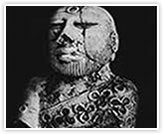
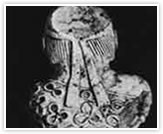
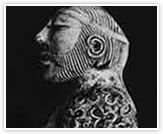
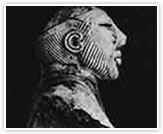
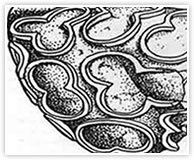
Steatite Statue Fragment; Mohenjodaro (Sd767); Trefoil-Decorated Bull; Traces Of Red Pigment Remain Inside The Trefoils.
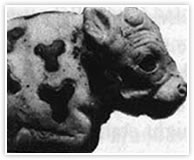
Statue, Uruk (W.16017), C. 3000 B.C.; Bull With Trefoil Inlays.
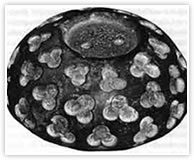
Tre-Foil Inlay Decorated Base: National Museum Of Pakistan, Karachi; After Mackay 1938
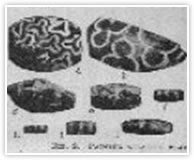
Trefoils Painted On Steatite Beads, Harappa.
The discovery of the king priest acclaimed by sir john marshall as “the finest piece of statuary that has been found at moenjodaro…. Draped in an elaborate shawl with corded or rolled over edge, worn over the left shoulder and under the right arm. This shawl is decorated all over with a design of trefoils in relief interspersed occasionally with small circles, the interiors of which are filled with a red pigment”.
The ‘trefoil’ is a symbolical motif of the three sun-disks fused together to represent the inseparable unity of power of gods of suns, water and earth.
The ustos of ajrakh printing firmly believe that the shawl draped on the figure of the king priest is ajrakh and the trefoil motif is actually kakar (cloud) pattern. This theory is debatable as no printing evidence has been discovered yet, although knowledge of spinning, weaving and the magical process of ‘manjitha’, madder dyeing of cotton cloth, was established; however, needles were unearthed and the possibility that the patter was embroidered and printed cannot be ruled out.
Panini wrote in the first millennium b.c, about cloths known by their colors: ‘nila’ was the cloth dyed with indigo, ‘lohitaka’ was red; madder-dyed cloth- ‘laksa’, the red from lac, and ‘kalaka’, the black cloth.
R.pfitser in his monograph ‘les toiles impremees de fostat et ‘hindustan’, states that some of the fragments were printed on the western coast of the sub-continent as late as the fourteenth centuary, while lamm believes that some of the fabrics can be as early as the abbasid dynasty (8th-9th centuary a.d)
There are long lapses of time where there is no evidence of textile specimen or any reference in the documented history of manufactured cloth till the seventeenth century a.d. There was a great demand in england for cotton goods.
A factory was set up, and on viewing of the consignment from sindh, the directors wrote “the synda factory for aught we yet perceive, hath most cause to be cherished and pursued than any of your calico factories. For the goods received from thence, this shipping are the flower of the whole parcel and are preferred here before all others…”
The east india company maintained a factory in sindh from 1636-1662; and then after a lapse of 96years, reopened the factory for the second time in 1758, and continued till 1775. This time the company did not purchase cloth and indigo, but instead sold broad-cloth and woolens, and bought sindhi cattle, batty or unhusked rice and saltpeter.
An exhibition and fair was held in karachi in 1869 and according to the records, prizes were awarded to items termed ‘ujrak or coloured sheets”.
Patterned and printed fabrics of sindh had become a national industry in the seventeenth century. Weavers by then were world famous and this art form was part of their everyday existence.
When the britishers traders left, there was a change of government in sindh; but still the weaving activity continued. In the nineteenth century, the imposition of foreign rule, following the conquest and annexation of sindh to the british raaj, brought an upheaval in the life of sindh and the history of its arts.
Partition proved to be a very crucial time for ajrakh prints. It divided the artisians and broke the flow of this crafts. ‘khatri’ being the main caste came to india and settled in gujrat and rajasthan.
Barmer became the main residence of ajrakh printing in rajasthan.
The change brought in new concepts, new commerce and economy, new symbols in tastes and fashion; the clarity of form disappeared, the vision of the craftsmen became lurred, that was the decline of the indigenous textile industry; the old centers gradually withered and perished.
A well equipped dyers workshop was also excavated at Moenjodaro “…… The purple dye on a scrap of this cotton material is thought by Messrs Gulati and Turner to be of the madder class” The piece of cotton was preserved by the sliver salts of the vase, but apart from this fragment no textile has remained intact due to destructive nature of the soil.
The discovery of the King Priest acclaimed by Sir John Marshall as “the finest piece of statuary that has been found at Moenjodaro….draped in an elaborate shawl with corded or rolled over edge, worn over the left shoulder and under the right arm. This shawl is decorated all over with a design of trefoils in relief interspersed occasionally with small circles, the interiors of which are filled with a red pigment “. Exactly the same trefoil pattern is found on the bodies of Sumerian bulls in Mesopotamia, where the concept of trinity was evolved. Trefoil also occurs on the royal couch of Tutankh-Amen and on the Hathor cow. It is interesting to note that the National Museum of Karachi has a small faience bead from Monenjodaro with the same trefoil pattern around it. The “trefoil” is a symbolical motif of the three sun-disks fused together to represent the inseparable unity of power of gods of sun, water and earth.
The Ustos of Ajrak printing firmly believe that the shawl draped on the figure of the King Priest is Ajrak and the trefoil motif is actually kakar (cloud) pattern. This theory is debatable as no printing evidence has been discovered yet, although knowledge of spinning, weaving and the magical process of ‘Manjitha’, madder dyeing of cotton cloth, was established; however, needles were unearthed and the possibility that the pattern was embroidered and not printed cannot be ruled out.
During the early Aryan period the Rig-veda Samitha, composed in the second millennium B.C. refer to Sindh as ‘suvasa’ - the maker of good cloth, and in the first century A.D. the cloth imported by the Romans from the East was known as ‘cendatus’ or cloth from Sindh.
There are long lapses of time where there is no evidence of textile specimens or any reference in the documented history of manufactured cloth till the seventeenth century A.D.
In 1659, a young Venetian adventurer Niccolao Manucci, called “A Pepys of Moghul India”, came to Sindh and took part in the siege of Bukkur. He entered the service of Dara Shikoh as an artillery man and served him in the war against Aurangzeb. In his vivid mentions that Sindhis made”…..coverlets for beds very beautiful chintzes very cheap, a cotton cloth ‘jurries’, very fine and soft which lasts beyond all cloths I have used”.
There was a great demand in England for cotton goods; the East India Company was marking large purchases of cloth in its three ‘calico provinces’ - Bengal, Gujarat and the Coromandel. At that time some of the important towns situated on the Indus Thatta, Nusserpur, Sehwan, Kandiaro, Ranipur, Gumbat, Sann and Bukkur were pulsating with weaving activity; Thatta and Nusserpur each had three thousand in Sehwan, and hundreds in other towns.
William Fremlin, a merchant in the service of the East India Company visited Thatta and wrote to his colleagues advising to set up a factory at Thatta,” ……….of all sorts of Indian goods, none are in such request as those of Synda, nor find more reddic vend, as being in reguarde of their substance and colors most requirable”.
Subsequently a factory was set up, and on viewing of the consignment from Sindh, the Directors wrote “The Synda factory for aught we yet perceive, hath most cause to be cherished and pursued than any calico factories For the goods received from thence, this shipping are the flower of the whole and are preferred here before all others……...”.
Panini writes in the first millennium B.C. about cloths known by their colours; ‘Nila’ was cloth dyed with indigo.” Lohitaka was red; madder-dyed cloth- ‘laksa’ the red from lac. and ‘kalaka’ the black cloth.
The earliest specimens of patterned cottons seem to have been retrieved from Fustat harbour of Old Cairo. Since these were purchased from dealers in the art market in Cairo, the exact location of discovery has not been authenticated. The cotton fragments have simple patterns printed with small sized blocks, then resist dyed in indigo. The white patterns commonly have a blue or a red background. The fabrics discovered at Fustat are of a coarse weave; they formed the main bulk of export trade from the western sub-continents to Arabia and Africa.
R. Pfitser in his monologue, Ies toiles impremees de fostat et ‘Hindustan’, states that some of the fragments were printed on the western coast of the sub-continent as late as the fourteenth and fifteenth century , while l am believes that some of the fabrics can be dated as early as the Abbasid dynasty (8th 9th Century A.D).
The East India Company maintained a factory in Sindh from 1636-1662; and then after a lapse of 96 years reopened the factory for the second time in 1758 and continued till 1775.This time the company did not purchase cloth and indigo. But instead sold broad-cloth and woollens; and bought Sindhi cattle, batty or unhusked rice and saltpetrc.
Sindh historically has been trade-oriented and therefore receptive to external influences. Similar printing techniques were practiced in Iran, but the Sindhi fabric evolved a distinct style of its own. The craftsmen with their inner sensibilities and intuitions gradually developed the printing techniques from simple resist patterning on one side of the fabric to the rich tonal two-sided resist printed fabric Ajrak.
An exhibition and fair was held in Karachi in 1869 and according to the records, prizes were awarded to items termed “Ujruk or coloured sheets”.
Patterned and printed fabric of Sindh had become a national industry in the seventeenth century. Weavers by then were world famous and this art-form was part of their everyday existence.
When the British traders left, there was a change of government in Sindh; but still the weaving activity continued. In the nineteenth century the imposition of foreign rule, following the conquest and annexation of Sindh to the British Raaj, brought an upheaval in the life of Sindh and the history of its arts.
The change brought in new concepts new commerce and economy, new symbols in tastes and fashion; the clarity of form disappeared the vision of the craftsmen became blurred and that was the decline of the indigenous textile industry.